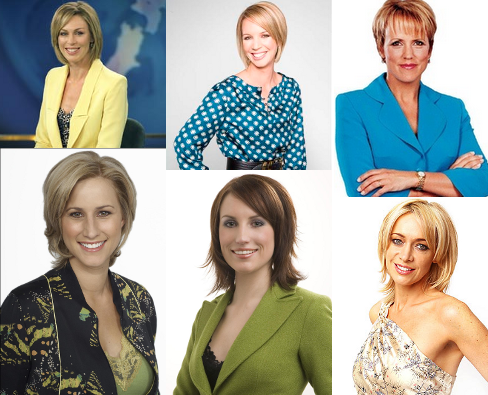A post by Janet Wilson expresses a general conspiracy theory I’ve held for a long time about why radio news is usually better than TV news: because the people are chosen for different qualities. To an extent the “beauty bias” is present in every field, and of course, even in news it is simplistic — there are a host of other factors to do with resourcing, format, training and so on. As in almost all fields — and for the same sorts of reasons — these pressures weigh much more heavily on women journalists than on men, and consequently the aesthetic homogeneity of NZ’s top female TV presenters is striking:

What Janet calls “tits and teeth” selection really matters: people instinctively trust attractive people more than unattractive people (as long as they’re not too attractive), and broadcast news is all about projecting authority and trustworthiness via a predominantly visual medium. Dress and bearing are also relevant — as is voice, which is even more important in radio. But those things can, to a much greater extent, be worked on or around.
So TV news is biased in favour of attractiveness. In general, a presenter’s job is to present — their newsgathering, interviewing and editorial skills are backgrounded to a considerable degree. So this bias isn’t entirely unjustified for presenters, but the problem is that it’s also clearly evident in the journalistic ranks from which presenters are drawn. While it does not exclude journalistic quality the beauty bias does weight against it. Because the jump from reporter to presenter is a crucial part of a broadcast journalist’s career arc, and being unwilling — or unable — to fit the pattern is an explicit and well-known limitation to advancement, it likely dissuades people who might otherwise make outstanding broadcast journalists — which society desperately needs — from entering the profession. As Janet notes, the bias also selects against experience, because while men tend to become “distinguished” as they age (strengthening their gravitas) women do not, and those who don’t retain their youthful dash paradoxically become less favoured as their screen experience increases.
A case in point on this last point has lately been evident in the most trivial forum: Breakfast, on TV One. My wife, at home with our daughter, remarked on the greater capacity of One News anchor Wendy Petrie to deal with co-host Paul Henry’s soft-gonzo screen persona while she covered for Pippa Wetzell recently: a sort of dismissive indulgence, as if of a poorly-behaved child on his birthday. The customary pairing is a classic mismatch: Henry dominates the studio while Wetzell — herself a quality presenter, as we occasionally see when Henry is absent — is often forced into the role of slightly-embarrassed fall-gal. Petrie, with close to a decade’s primetime hard-news presenting experience under her belt, is out of Henry’s league and she knows it.
Of course, she herself has the beauty bias on her side. But the question is: how long does she have left? And how many other talents have we lost — or never found — due to the dire ravages of crow’s feet, a poor hairdo, a few additional kilos, or a mismatched outfit?
(Thanks to Naly D for the link to Janet’s article.)
L
PS: I’d like to endorse Nicola Kean’s campaign to go to Columbia Journalism School, as others are doing. Go and vote for her, and perhaps she’ll do better than another well-known graduate from these parts.
